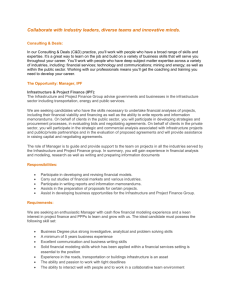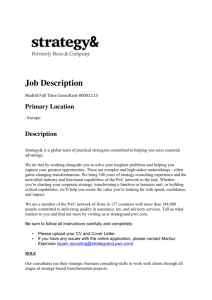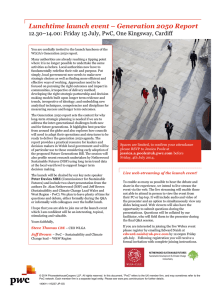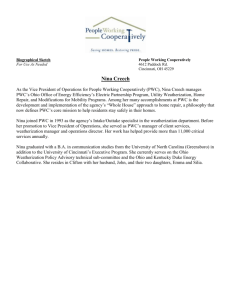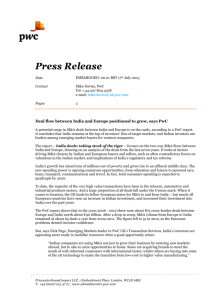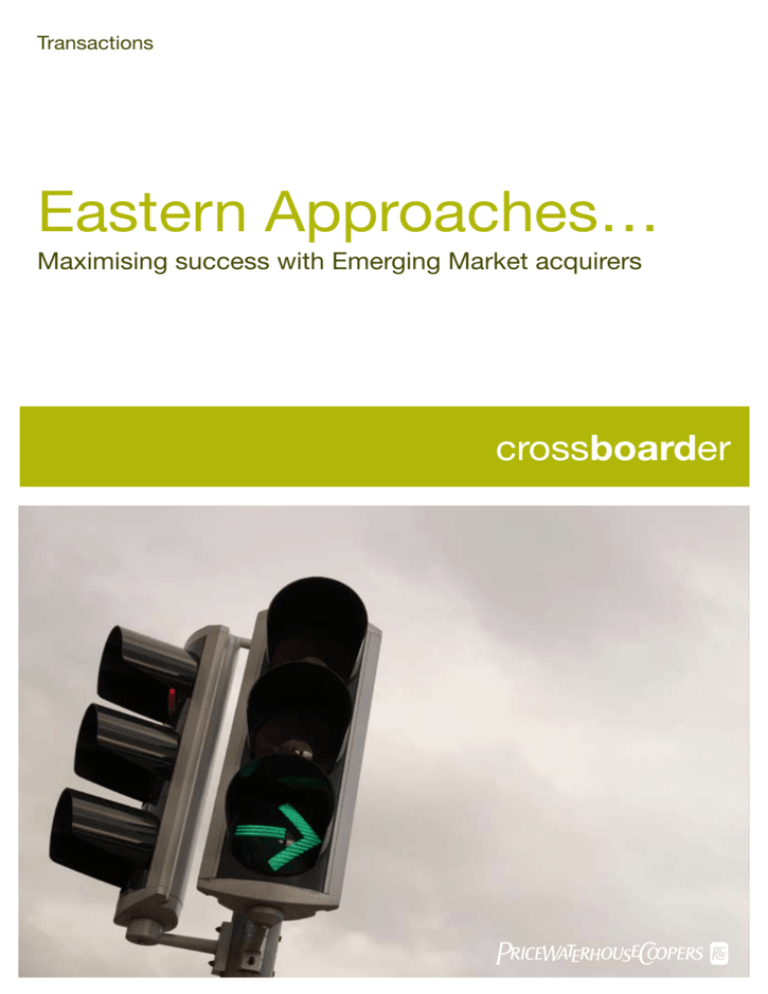
Transactions
Eastern Approaches…
Maximising success with Emerging Market acquirers
crossboarder
pwc
Business owners in Western Europe are increasingly
recognising companies and institutions from Emerging Markets
(EM) as serious contenders when searching for a strategic
partner or when attempting to sell their business outright.
But do Western European vendors understand EM purchasers
and their respective cultures well enough to successfully
negotiate the best deal for their business?
What can you do to maximise the success of these cross
border transactions?
Destination ‘Western Europe’
Mergers and Acquisition (M&A) activity by Emerging Market1 (EM) entities in Western
Europe has increased dramatically over the last six years. During this period, EM entities
made some 844 acquisitions or investments in the region with a combined value of
nearly €120bn.
As result of the ‘credit crunch’ and the global economic slowdown, 2008 has been a
very weak year for global M&A activity. Despite this, 2008 was a record year for M&A
transactions conducted by EM acquirers or minority investors, with an unprecedented
256 completed deals.
Whilst we expect the overall slowdown in the global M&A market to continue in
2009, there will be an abundance of attractive transaction opportunities in the midmarket segment for EM buyers, driven by strategic investment rationale. There are
fundamentally strong, under-geared EM entities that are looking to acquire sound
Western European targets. Having established themselves domestically as successful
enterprises, they will continue making acquisitions abroad.
This could represent an opportunity to get a strategic EM investor on board (through
selling a minority or controlling stake) that could not only provide you with additional
funding, but also access to high-growth markets. If your company is facing a possible
distressed situation, this could also be a viable strategic option to consider, which could
allow your company to thrive in the future.
However, many Western European vendors can still be reluctant to deal with EM buyers
as they have concerns over their ability to deliver on the transaction. Similarly, some EM
buyers can feel that they are included in the sale process only as an option of last resort,
after the vendors have tried and failed to sell their company to Western European trade
and financial counterparties.
So what can you do to improve your chances of a successful sale? What do you need
to know and how can you ensure your business is positioned appropriately so that it
attracts interest from EM buyers?
Mergers and Acquisition
(M&A) activity by EM
entities in Western Europe
has increased dramatically
over the last six years.
Some 844 acquisitions or
investments were made in
the region with a combined
value of nearly €120bn.
Whilst we expect an overall
slowdown in the global
M&A market in 2009, there
will be an abundance
of attractive transaction
opportunities in the midmarket segment for EM
buyers, driven by strategic
investment rationale.
Whereas the transaction lifecycle will be broadly similar to dealing with other Western
European bidders, there are numerous issues that will need to be addressed in order to
make the deal work for both parties, especially around bridging cultural differences.
This paper offers some insights on the steps that you as a vendor might consider taking
in order to bridge these differences and make your business more accessible and
attractive to a prospective EM buyer.
Our comments focus on the initial phases of the deal and are by no means exhaustive.
Through our experience of advising on cross-border transactions, we know very well
that every deal is unique and the corresponding challenges are almost always different.
We hope that this document will provide some food for thought and we look forward to
continuing to work with you.
Chris Hemmings
PricewaterhouseCoopers (UK)
Global Corporate Finance Leader
February 2009
1 Emerging Markets are countries or regions with high growth economies, including India, China, Russia, CIS, Latin America and
Central and Eastern Europe.
Eastern Approaches…
M&A trends and deal drivers
2008 witnessed an
unprecedented 256 deals
where EM buyers acquired
Western European
businesses with an overall
value in excess of €45bn.
Mergers and Acquisition (M&A) activity by EM entities in Western Europe has increased
in each of the last six years, with 2008 encompassing an unprecedented 256 deals with
an overall value in excess of €45bn.
M&A Activity 2003-2008
Emerging Market Acquirers / Western European Targets
Equity value (€bn) and number of deals by year
256
50
200
40
150
188
30
151
132
25
100
110
20
Number of deals
Value of deals €bn
35
78
15
61
50
10
5
0
2003
2004
CEE
2005
China
India
2006
Latin America
Middle East
0
2007
2008
Russia / CIS
Number of Deals
Source: Dealogic January 2009
Middle Eastern entities and sovereign wealth funds (SWFs) have set the pace,
accounting for nearly 40% of cumulative transactions by value and 19% by volume
between 2003 and 2008. Chinese private or state-owned enterprises (SOEs) account for
one-fifth of the deals. Indian multinationals looking for technology, brands and routes
to markets have been the most active by volume, performing one-third of the overall
transactions, which account for 18% of the value. Russia’s energy companies and high
net worth entrepreneurs have completed about 15% of the transactions.
M&A Activity 2003-2008
Emerging Market Acquirers / Western European Targets
By target country destination (% of total deals by value)
United Kingdom
57%
France
10%
Switzerland
7%
Germany
6%
Netherlands
6%
Belgium
3%
Spain
3%
1%
Greece
2%
Other
0%
10%
Source: Dealogic January 2009
Eastern Approaches…
36
5%
Italy
1
45
20%
30%
40%
50%
60%
M&A Activity 2003-2008
Emerging Market Acquirers / Western European Targets
By target country destination (% of total number of deals)
United Kingdom
33%
Germany
45
19%
France
36
10%
8%
Italy
7%
Spain
6%
Netherlands
5%
Switzerland
4%
Austria
3%
Belgium
Other
5%
0%
5%
10%
15%
20%
25%
30%
35%
40%
Source: Dealogic January 2009
The United Kingdom has been the largest recipient of inbound M&A activity by EM
acquirers in the last six years, accounting for 57% of overall transactions by value and
33% by number. The country’s financial services industry and its openness to and
appetite for dealing with EM investors have been significant deal drivers.
We predict that
transactions in 2009 and
beyond will be driven by
fundamentally strong EM
buyers looking for Western
European acquisitions.
This activity will be
motivated by a number of
factors including market
expansion, backward
/ forward integration,
knowledge and technology
acquisition, economies
of scale, access to
and association with
international brands and
risk diversification rationale.
Deal drivers for 2009 and beyond
There will be an overall slowdown in global M&A activity in 2009, as a result of the
reduction in available credit and weak state of the global economy.
It is expected that these conditions will not leave EM entities unaffected, and some
will direct their efforts towards their domestic operations and delay their overseas
investment plans. Some larger Chinese enterprises, for example, are concentrating on
streamlining their domestic operations and will be looking at foreign acquisitions on
a more reactive, rather than proactive, basis. However, some Indian companies, for
example, have continued to make outbound acquisitions in the second half of 2008,
in some cases, competing for assets with other Indian bidders, as in the case of Axon,
where both HCL Technologies and Infosys were keen contenders.
The falling valuations of some Western European companies and the distressed position
of others, will entice some more opportunistic EM enterprises to look for overseas
investments. At the same time they will be notably more selective in their investments,
and will look beyond the valuations in order to identify fundamentally sound companies.
Transactions that do take place in 2009 and beyond, will be mostly driven by
fundamentally strong EM buyers looking for Western European acquisitions, motivated
by market expansion, backward / forward integration, knowledge and technology
acquisition, economies of scale, access to and association with international brands
and risk diversification rationale.
Eastern Approaches…
2
Challenges in cross-border transactions
In a survey conducted
by PwC, global CEOs
identified cultural issues /
conflicts as representing
the most substantial
obstacle to success in
cross-border M&A.
There are numerous challenges that must be addressed in order to make a cross border
transaction work. In a survey conducted by PwC, global CEOs identified cultural issues /
conflicts as representing the most substantial obstacle to success in cross-border M&A.
Key obstacles for cross-border M&A
Cultural issues/
conflicts
54
Unexpected costs
45
Realising the expected value
of the transaction
Poor management of
human resources
40
40
Conflicting workforce
expectations
Conflicting regulatory
requirements
Assessing the tax
implications
Accessing finance at the
right price
32
31
21
21
Stakeholder opposition
18
Trade barriers and
protectionism
14
0
10
20
30
40
50
60
Source: PwC Global CEO Survey 2009
It is important to note that these issues are not unique to EM acquirers, and these types
of challenges are prevalent in all cross-border transactions.
Although Western European vendors can have concerns about the ability of EM buyers
to deliver on their side of the deal, the volume of deals done by EM acquirers over the
last six years is a clear indication that EM buyers are able to close deals. Bid processes
are becoming quite common in domestic EM transactions and this is helping EM
acquirers in their appreciation of overseas M&A practices. However, some EM buyers,
especially those in the mid-tier segment attempting an outbound acquisition for the first
time, still need to develop a better understanding of Western European sales processes
and find ways to gain better visibility of businesses for sale in Western European
economies.
So what are the steps that you need to take to make sure that you understand your
potential EM suitor, to make your company more accessible to an EM buyer, and to
maximise your chances of successfully completing the transaction? The remainder of
this document provides some insight on the steps you might want to consider when
marketing your business to a potential EM acquirer.
3
Eastern Approaches…
Tailoring your disposal strategy towards
EM buyers
Typical Western European Disposal Process
Develop sale strategy
Marketing
Evaluation/
Final offers
Negotiation/
completion
Sale strategy
Confidentiality
agreements
Evaluate offers and
create short list
Heads of
agreement/SPA
Provide
sales document
Negotiation
strategy
Negotiation
Sector outlook
Performance
review & valuation
Opportunities
Initial
meetings
Additional
information
Site visits
List of potential
purchasers
Indicative
offers
Identify potential
areas of weakness
Due diligence
Confirmatory
due diligence
Sale completion
Vendor assistance
Final offers
Vendor
due diligence
Sale document
(IM)
Evaluation of offers
Identify potential EM investors from the outset
Getting an EM purchaser or investor on board should not be viewed as a tactic of last
resort; in the current climate it could be a vital strategic option to consider, as a means
of allowing your company to thrive, or simply survive, as a going concern.
Researching the key potential candidates within each EM country, and focusing on
entities that have done cross-border transactions in the past could be a good starting
point when searching for potential bidders. This will be a more difficult task when trying
to identify rising mid-market players as, unlike in Western Europe, there is often limited
information about these entities in the public domain. Appointing financial advisors with
a local presence, who have relationships with these companies, could help you identify
and shortlist credible bidders.
Tailor the sales documents
Getting an EM purchaser
or investor on board
should not be viewed as a
tactic of last resort; in the
current climate it could be
a vital strategic option to
consider, as a means of
allowing your company to
thrive, or simply survive,
as a going concern.
The documentation needed for a transaction with a prospective EM acquirer will be
manifestly similar to a ‘standard’ deal with a Western European counterpart, but should
be tailored to accommodate certain facts and circumstances. It will still be necessary
to produce an Information Memorandum and ‘teaser’ document, but there will be
differences.
These differences, as articulated overleaf, are sufficiently material that we would
recommend the use of tailored ‘teasers’ appropriate to each market that will be involved
in the bidding process. This can mean producing several different versions of the
documents, taking into consideration the different strategic priorities of EM acquirers, as
well as their customary business and cultural norms.
Eastern Approaches…
4
Understand the strategic rationale of EM purchasers
It is vital to understand the strategic priorities driving a potential EM acquirer to make
a cross-border acquisition and tailor the sales documents accordingly: why are they
interested in making an acquisition and what will they value in the target entity?
These strategic motivations can vary from country to country, and from buyer to buyer,
but examples of what these priorities might be are set out below:
China – technology transfer
The internationalisation of Chinese firms is driven largely by their desire to gain greater
advantage within the Chinese market, for example by seeking new technologies,
expertise or brands, or to further China’s established ‘national agenda’ in sectors
such as aerospace, energy and natural resources. In positioning a business for sale to
Chinese buyers, it is therefore important to consider carefully how your business will
help the investor to increase its market share in China.
India – distribution networks
There have been numerous deal drivers for Indian acquirers executing outbound
transactions – these include backward / forward integration, access to markets,
knowledge and technology, economies of scale, and access to and association with
international brands.
Indian companies also have a significant domestic market to develop and it is therefore
important to illustrate how your business can help to build or enhance a market position
in India. At the same time, Indian companies are also interested in developing global
businesses. As such, they will be interested in brand positioning and in understanding
how your business can fill their gaps in product and service offerings and achieve
greater geographic coverage.
Middle East – prestige is important
The prestige factor has often been important for Middle Eastern buyers in Western
Europe with a considerable number of deals executed so far by SWFs into high-end
property development, financial services and luxury brands. Middle Eastern SWFs are
also seeking to build industries in strategically important sectors such as aerospace, or
to develop industries such as leisure and tourism which can attract people to the Middle
East region and encourage them to lengthen their stop-overs.
Latin America – growth through globalisation
South American companies are increasingly trying to expand overseas to grow and
diversify their risks in terms of markets, raw materials and exchange rates. They are
seeking to enter Western European markets by establishing a bridgehead in one country
and using it as a platform for further acquisitions and expansion.
Russia/CIS – cash rich investors
Aside from the expansive ambitions of state-controlled energy companies, the majority
of Russian transaction activity in Western Europe so far has been focussed on capital
raising, luxury goods and property, often by wealthy, brand conscious individuals.
5
Eastern Approaches…
Emphasise how the transaction could help the
bidder’s position
With EM buyers being geographically distant to Western Europe for the most part,
deals are less likely to be driven by cost synergies and more likely to focus on
market entry, technology, brands, customer relationships, distribution networks and
economies of scale.
You should tailor your sales documents emphasising how your company can help
potential acquirers achieve their strategic goals, not only in new Western European
markets but, just as importantly, in their domestic space.
Do you have technologies that can be used in EMs?
Promoting technologies and / or brands which may be employed to improve the
EM company’s operations at home, and emphasising your company’s management
skills, will serve to highlight how your deal could represent a significant gain for the
EM business.
Have you successfully sold products in EMs?
If so, state this in the tailored teaser and Information Memorandum. Articulate the
reasons why your products have been successful abroad and how you think they
can add value to the purchaser’s business.
Tailor the presentation of financial information
Potential EM acquirers will want to be provided with the types and format of
financial figures with which they are familiar. Some EM buyers, especially those
from the Far East, place greater emphasis on net assets than on cash flow and
EBITDA multiples.
Other EM acquirers, that are not as interested in the value that can be attached to
intangible assets, such as a strong brand, may exclude assets such as intellectual
property and goodwill from their valuations. Therefore a comprehensive explanation
of the value attached to such assets may be required by the vendor.
Strategic investments
A number of Western European
companies are currently struggling
to meet the terms of loan
covenants or pay the coupon
or interest on issued debt, as a
result of the credit crunch and
stagnating economic prospects.
Consequently, they are facing
administration or receivership
procedures and are branded as
distressed assets.
EM buyers have demonstrated
that they can be prepared to look
beyond short-term financial issues
and high levels of gearing. The
acquisition of a Western European
company may have significant
strategic value to an EM buyer,
and could still achieve a good
valuation. Indeed, a declining
market in Western Europe may
well translate to a growth market
in an emerging economy, if the
brands, products or technologies
could be successfully transferred.
Eastern Approaches…
6
Marketing your company to EM buyers
Once you have identified potential EM acquirers and have produced the tailored sales
The decision-making
documents, you should make your approach. However, difficult questions remain to
processes in EM
be answered: whom do you approach and when is the best time to do that in order to
maximise the chances of success?
companies are often
consensus-based, making Identify who is in charge
the acquisition process
It is vital to understand who is pulling the levers of power in an EM acquirer. For mid-size
companies, it is not as simple as looking at the organisational chart and selecting the
significantly slower
finance director or corporate development director, typical steps that you would undertake
compared to Western
for a Western European counterparty. For most larger EM entities, however, the process
European counterparties. need not be very different.
Western European companies hoping to attract EM buying interest should fully research
the EM entity’s ownership structure and background. EM corporate structures can be
very complex, and not transparent, sometimes with more informal decision-making
arrangements in place, with owners or patriarchal figures wielding the real influence.
Timing is everything
Many EM acquirers, in particular those from India and China, are used to prolonged
acquisition processes with long periods of exclusivity, allowing them significant time to
make their indicative offers. Their decision making processes are often consensus-based,
making the process significantly slower compared to Western European counterparties.
It is not unusual, for example, for non-disclosure agreements to take four weeks to be
signed.
Western European vendors should be aware of this and should allow sufficient time for
decisions to be made. This is particularly important in an auction process, where EM buyers
would normally be disadvantaged relative to Western trade or financial buyers, due to the
slower speed of their decision making, but also their relative inexperience in making crossborder acquisitions. In some cases, specifically for SOEs, every definitive offer has to go
through a series of approvals, including those from the relevant Government Ministry and this
may also slow down the process. Therefore in order to allow for a considered response from
the potential buyer, EM acquirers should be approached early in the disposal process, even
in advance of the main Western European bidders.
Meetings and communication flows
As in all deals, it will be necessary to build good personal relationships with the key
decision makers in the prospective acquiring entity, to supplement the discussions
between advisors. EM acquirers can prefer to build close personal relationships with the
key executives of the target business, specifically with the heads of the various business
functions.
Although advisors can play an important and valuable bridging role between the chief
protagonists, many EM entities, particularly those from India and China, prefer to deal directly
with the principals. For Middle Eastern buyers, status and rank are important and they will
want to know exactly who they are dealing with. You should therefore allow sufficient time to
build relationships with the buyer. It will give both parties greater understanding of each other
and will significantly improve the chances of completing the deal.
This will always be easier and in the end more successful if it is possible to involve
advisors sensitive to the local cultural differences of the relevant markets. Representatives
of the buyer will often be more open when dealing with someone in their own language
and who they believe understands their culture.
When using translators to communicate with the bidders, it is important to ensure that they
have a clear grasp of business and technical language. Working through translators will
also increase the time required to progress the deal.
7
Eastern Approaches…
Customised vendor due diligence
Vendor due diligence (VDD) is now an accepted practice in most Western European
markets as it can provide assurance to the purchaser, expediting and potentially
shortening the decision-making process. However, this exercise would only assist
the EM buyer if its scope is specifically tailored to meet their demands. Contacting
local advisors early in the process to ensure that the bidders’ requirements are
accommodated within the scope of the VDD report is a logical step. You could
arrange the engagement with your VDD providers so that you have the flexibility to
expand the scope of the project at a later stage of the process, providing top-up due
diligence in the areas that might interest the EM bidder.
You should also be prepared for some amount of “direct” due diligence by the EM
bidders through their own advisors, as complete reliance on VDD reports is unusual
for them, in particular if they view the VDD as an extension of the Information
Memorandum.
Explain the ‘rules of the game’
It is important to ensure that your prospective acquirer or partner fully recognises
the extent to which Western Europe is a transparent and regulated environment,
as well as what are the accepted norms of doing business. For example, some EM
purchasers are not used to signing confidentiality / non-disclosure agreements that
are common in Western European transactions.
Be ready to provide them with explanations of the nature of the industry and its
regulatory and political context, as well as the need to comply with local rules such
as the UK’s Takeover Code, in addition to the laws and regulations (e.g. on health
and safety, environmental liabilities, employment law and corporate governance)
applicable when running the business. Whereas this is often assumed knowledge
when dealing with Western European counterparties, you have to be prepared to
spend some time focussing on these points (both in your marketing documents
and verbally) to make sure that they obtain a full understanding of the legal and
regulatory environment.
Making the transaction work for both parties
Some Western European vendors might feel that they are ‘losing face’ within their
local community by selling to an EM buyer. This can be a particular concern for
family-owned businesses where local stakeholders may perceive such a sale as the
‘last resort’ and the business to have been in financial distress.
Address these concerns upfront with the potential EM purchaser and ask them to
provide a clear indication of their investment strategy in the short and the long term.
When doing so, also help them develop a localisation plan so that the transition
in ownership can take place smoothly. Many EM companies find it difficult to take
management control of a Western European company post-acquisition. Spending
time with a buyer to help them develop such a plan will generate significant trust and
confidence between the seller and the buyer.
Pre-emptive transaction
processes
The focus of this paper is on
auction deal processes, which
include the prospect of a number
of possible bidders. As many EM
acquirers are used to prolonged
sales processes involving
extended periods of exclusivity,
auctions, which take place in a
short and frenzied period of time,
have not generally been attractive
to EM buyers.
However, there are a number of
EM bidders actively considering
acquisition opportunities in
Western Europe. This could
represent a transaction
opportunity, especially for:
•private equity vendors looking
to exit from some of their
portfolio investments;
•companies looking to delist from
a stock exchange and find a
strategic or financial backer; and
•companies facing industry
consolidation trends and
looking for a partner in high
growth markets.
We believe that it is likely that
there will be more direct or preemptive transactions in 2009,
initiated both by bidders and
vendors.
In order to gain more comfort over the credibility of a mid-tier EM acquirer, you
could ask the bidder for access to their records, so that you could commission
reverse due diligence to understand better the quality of their financial statements,
internal controls and corporate governance standards. The EM bidder may not
be accustomed to this approach, unless there is going to be combination of
businesses, but your advisor could assist you in conveying this message in the most
effective and diplomatic way.
Eastern Approaches…
8
Be prepared to negotiate
hard on the valuation
element of the offer, and
think outside the scope
of the intrinsic value of
the business, considering
how much the company
is worth from the point of
view of the EM acquirer.
9
Eastern Approaches…
Receiving indicative offers
The indicative offer given by some prospective EM acquirers might not be in the same
format as other Western European bidders, and will depend on the past cross-border
M&A experience of the EM buyer and the financial advisors assisting them.
Be prepared to negotiate hard on the valuation element of the offer, and think outside of
the scope of the intrinsic value of the business, considering how much the company is
worth from the point of view of the EM acquirer.
Also be aware of the different negotiating styles of EM buyers. The modest and
deferential negotiating style of some Indian buyers can mean that it is sometimes
difficult to identify what their position is and where their priorities lie, whereas some EM
negotiators can continually try to reopen discussions, demanding discounts on the price
or last minute government subsidies and tax exemptions.
Concluding thoughts
The impact of the credit crunch is curtailing all forms of M&A
activity. Despite this, the seemingly irresistible movement of
global economic gravity towards Emerging Markets means that
transactions with EM partners will be more common. With each
new deal announced, EM buyers will win greater acceptance as
sound, commercial M&A partners.
By tailoring your sales documents to take into consideration the agenda of the EM
purchaser, involving them in the process at the right time, communicating with them
appropriately, and addressing cultural differences and potential expectation gaps, you
will make your business more accessible to them, increasing the chances of taking the
opportunity to the next phase of the deal and ultimately to a profitable close.
Appointing experienced deal advisors on both sides of the transaction will help you to
manage the transaction and assist you with the financial and operational elements. They
should also provide you with a means of bridging any cultural gaps.
PwC has been successfully advising on cross-border deals for many years. We
know that each deal has unique requirements with corresponding opportunities and
challenges, and our experience and our people can help guide you through each stage
of the transaction cycle to a fruitful conclusion.
PwC experience in cross-border transactions
• Over the last 10 years, PwC advised on more than 3,200 deals
globally, of which 39% were cross-border
• During the last five years, we advised on 100 Emerging Market
transactions, with a combined deal value of $12.2bn
• In 2008 alone, PwC advised on 82 European cross-border deals with
a combined deal value of $8.1bn
Eastern Approaches…
10
Key contacts
Global Corporate Finance Leader
Chris Hemmings
+44 20 7804 5703
chris.hemmings@uk.pwc.com
UK
China
Neil Sutton
Xie Tao
+44 20 7213 1074
neil.sutton@uk.pwc.com
+ 86 10 6533 2002
tao.xie@cn.pwc.com
Germany
India
Werner Suhl
Bharti Gupta Ramola
+49 69 9585 5650
werner.suhl@de.pwc.com
+91 124 4620503
bharti.gupta.ramola@in.pwc.com
France
Middle East
Noel Albertus
Nitin Khanna
+33 6 07 43 66 81
noel.albertus@fr.pwc.com
+ 971 4 3043200
khanna.nitin@ae.pwc.com
Benelux
Russia / CIS
Andries Mak van Waay
Michael Knoll
+31 20 568 6509
andries.mak.van.waay@nl.pwc.com
+ 7 495 967 6058
michael.knoll@ru.pwc.com
Switzerland
CEE
Philipp Hofstetter
Chris Butters
+41 0 58 792 1506
philipp.hofstetter@ch.pwc.com
+420 251 151 203
chris.butters@cz.pwc.com
Canada
Latin America
Keith Mosley
Jorge Bacher
+1 416 941 8307
keith.mosley@ca.pwc.com
+5411 4850 6814
jorge.c.bacher@ar.pwc.com
Australasia
Southern Africa
Tom Fenton
Simon Venables
+61 2 8266 2759
tom.fenton@au.com.com
simon.venables@za.pwc.com
+27 11 797 5660
USA
Japan
For US residents requiring information on
corporate finance related services, please contact
our registered FINRA Broker Dealer within the
US, PricewaterhouseCoopers Corporate Advisory
and Restructuring LLC, which can be contacted
directly at:
Michael Milani
+1 312 298 2755
michael.milani@us.pwc.com
11
Eastern Approaches…
Matthew Wyborn
matthew.j.wyborn@jp.pwc.com
+81 3 6266 5740
About PricewaterhouseCoopers
The member firms of the PricewaterhouseCoopers (PwC) network provide
industry-focused assurance, tax and advisory services to build public trust
and enhance value for its clients and their stakeholders. More than 155,000
people in 153 countries across our network share their thinking, experience and
solutions to develop fresh perspectives and practical advice.
About Crossboarder
Crossboarder is a series of briefings for the Board on the opportunities and
challenges presented by high growth economies.
Find out more!
Listen to our podcast accompanying this publication at
pwc.co.uk/emergingmarkets
Important notice for US residents: In the US, corporate finance services are provided by PricewaterhouseCoopers Corporate Advisory and
Restructuring LLC, a member of the FINRA and SIPC. PricewaterhouseCoopers Corporate Finance and Restructuring is not engaged in the practice
of public accountancy.
This publication has been prepared for general guidance on matters of interest only, and does not constitute professional advice. You should
not act upon the information contained in this publication without obtaining specific professional advice. No representation or warranty (express
or implied) is given as to the accuracy or completeness of the information contained in this publication, and, to the extent permitted by law,
PricewaterhouseCoopers does not accept or assume any liability, responsibility or duty of care for any consequences of you or anyone else acting,
or refraining to act, in reliance on the information contained in this publication or for any decision based on it.
Eastern Approaches…
12
pwc.com
© 2009 PricewaterhouseCoopers. All rights reserved. ‘PricewaterhouseCoopers’ refers to the network of member firms of PricewaterhouseCoopers
International Limited, each of which is a separate and independent legal entity.
Design: hb03944

